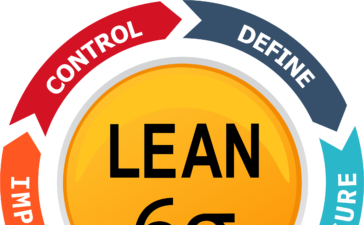Lean Six Sigma Principles
In today’s business world there are various methodologies of quality management. Companies prefer to apply Six Sigma and Lean methodology to form Lean Six Sigma Principles. This amalgamation helps to improve projects and services in companies. Before discussing the 10 Lean Six Sigma Principles, let us understand what is Lean Six Sigma?
Lean Six Sigma
Lean Six Sigma is based on data and facts that help to block defects. Combining Lean and Six Sigma helps to reduce waste of assigned resources along with employees’ time and effort. It is believed that in the 1980s, Lean Six Sigma first originated in the US. Only after 2002, a deeper level of understanding of this method was lensed by several organizations. At present there are various levels of Lean Six Sigma, they are :
- White Belt
- Yellow Belt
- Green Belt
- Black Belt
- Master Black Belt
These levels are awarded to the Individuals with Lean Six Sigma certification, who pursue their career in Quality Management. Each of the levels denotes the extent of understanding and knowledge of Six Sigma concepts. The DMAIC i.e Define, Measure, Analyze, Improve, and Control process is the outline used for focusing on the client’s detailed statistical techniques and data.
Companies that look ahead to apply the Lean Six Sigma methodology need to focus on the 10 basic principles.
Lean focuses on removing wasteful activities, Six Sigma focuses on improving quality by disconnecting the reasons for defects. Let us have a look at the 10 Lean Six Sigma Principles :
1. Customer-centric
Clients are given much importance often in businesses as they hold the reputation of the company. Lean Six Sigma methodology helps such businesses to understand the needs of their clients. The primary goal is to deliver maximum benefit to the customer and establish standard quality as per the client’s requirement or market demand.
The business can retain its customers after the projects get delivered as per the client’s requirements.
2. Discover the problems
This principle of Lean Six Sigma requires a map of the business processes. On mapping the complicated processes, those activities that do not add value to the clients can be removed. To do so, businesses need to accumulate data required to discover the area of the problem. Discovering and mapping help to improve your work processes.
3. Eliminate the variations
The current study revealed that variations take place in long processes that need to be carried out for complicated projects. Eliminating or changing such processes through Lean Six Sigma can decline the number of variations arising in project work. In this way, businesses can reach their desired target that is project quality.
4. Communication with the team members
There should be clear and understandable communication with the team members of an organization. When every individual working in a project team is well versed with the methodology, this principle i.e Lean Six Sigma methodology can be applied. Maintaining lucidity with the stockholders will help in reducing the cause of project negligence. Advanced certifications in Six Sigma are important for lessening the threats of project failure and certifying that the entire process runs steadily.
5. Flexibility
Lean Six Sigma focuses on introducing the changes occurring in an organization, during its implementation. In simple words, management has to prepare the workers to adapt to the changes that take place due to the Lean Six Sigma methodology. By hiring certified professionals with a black belt or green belt credentials, can be done. Such experts can explain the benefits of the method and how the workflow can be improvised. This helps to accelerate the modified process thereby benefiting the organization.
6. Eliminate the non-value-added steps
In the lean world, waste here means “non-value-added activity.” The seven wastes of lean are:
- Inventory
- Waiting
- Defects
- Overproduction
- Motion
- Transportation and
- Over-processing
Eliminating these wasteful activities helps companies to improve their operational planning and profitability.
7. Involve people in the process
In Lean Six Sigma culture process improvement is an integral part. You have to pay attention to the people involved in the process, in order to make the right decision about what needs to be upgraded. Lean Six Sigma also firmly advises you to have a dedicated process, an advancement team responsible for the Six Sigma processes. This is all because advancement doesn’t occur every now and then, it occurs as a result of collective efforts and shared vision.
8. Improvement
The primary goal of the Lean Six Sigma methodology is continuous improvement. Lean Six Sigma focuses exclusively on eliminating waste, as in people. Waste is defined as:
- Reworking
- Unnecessary planning
- Context switching
- Long time wait between the steps in the process
The goal mentioned is to reduce waste and not people in an organization. In this way, the company can improve their speed of delivery. Lean is also committed to added value, as continuous improvement also focuses on increasing value.
9. Creating Knowledge
This principle of creating knowledge ties into the concept of optimizing the whole. The lean method focuses on ways you can upgrade your organization. To drive this improvement, there should be an effort and a desire to learn more and more about production and Management. To succeed in a lean organization, there must be a company culture that prioritizes the acquisition of knowledge. This means that building the infrastructure is necessary to record and share the ideas in a way that would help everyone to learn something valuable. To make this possible companies must devote time to learning.
10. Fast Delivery
This is one of the chief Lean principles. The reason why Lean emphasizes fast delivery is all because of the feedback. The faster the products reach the customers, the quicker the organization receives feedback. That feedback can be used to enhance the products. This helps organizations to strive for continuous advancement.
Lean Six Sigma Certification is a great way to upgrade your potential as a leader in your own organization. Anyone looking to gain knowledge and experience in an organization must get certified. There are many such institutions that provide Lean Six Sigma courses. Henry Harvin is one of the top-ranked institutes that offers Lean Six Sigma courses. Let us have an overview of Lean Six Sigma Courses in Henry Harvin.
Henry Harvin’s Six Sigma Certification is ranked no.1 in the industry. The training program focuses on learning, live projects, monthly Bootcamp sessions, internship, job support, and career services.
Lean Six Sigma Green Belt Certification
The course helps in the enhancement of business processes and performance.
Key Highlights
- Training: 28 hours of online interactive classroom sessions
- Projects: Undergo projects in Lean Six Sigma and more
- E-learning Access: Abundant tools and techniques, video content, assessment, etc
- Certification: Get recognized certification from Henry Harvin ® Award-winning Institute
- Internship: Gain practical experience of learning
- Placement: 100% placement guarantee support
- Bootcamp: Regular boot camp sessions over the next 12 months
- Membership: One-year gold membership from Henry Harvin ® Quality Management Academy for the Lean Six Sigma Green Belt Course
Benefits of Gold Membership
- The e-learning access includes recorded videos projects and case studies
- The monthly boot camp session helps to brush up and upgrade the knowledge
- Job opportunities
- Learn interview skills with the team
- Gain access to resume writing, soft skill development, and more
Learning Benefits
- Certified Six Sigma experts are eligible for jobs in the analytical background
- Open to job opportunities
- Improve your CV and LinkedIn profile
- Gain skills to advance your career
- Gain knowledge to solve management problems
- Learn customer-centric actions
- Understand projects to develop high-quality products
The Lean Six Sigma Green Belt course curriculum covers 6 modules with projects, resume writing, and soft skill development. The mentors at Henry Harvin have 18+ years of working experience. Over 350+ lectures have been delivered by the experts.
Lean Six Sigma Black Belt Certification
The Lean Six Sigma Black Belt is one of the best certifications among all the six sigma courses. This course is an ideal choice for professionals looking for promotion to mid-management and senior management job profiles.
Key Highlights
- Training: 36 hours of online interactive classroom sessions
- Projects: Undergo projects in Lean Six Sigma, and more
- E-learning Access: Abundant tools and techniques, video content, assessment, etc
- Certification: Get recognized certification from Henry Harvin ® Award-winning Institute
- Internship: Gain practical experience of learning
- Placement: 100% placement guarantee support
- Bootcamp: Regular boot camp sessions over the next 12 months
- Membership: One-year gold membership from Henry Harvin ® Quality Management for the Lean Six Sigma Black Belt Course
Benefits of Gold Membership
- The e-Learning access includes recorded videos projects and case studies
- The monthly boot camp session helps to brush up and upgrade the knowledge
- Job opportunities
- Learn interview skills with the team
- Gain access to resume writing, soft skill development, and more
Learning Benefits
- With the Six Sigma Black Belt certification, you can acquire a top position in the corporate sectors
- Gain mastery in statistical-based decisions and data-driven problem solving
- Improve your CV and LinkedIn profile
- With the Black Belt certification, you can improve how to reach a higher-level position in the business
- Eligible for influential leadership roles and stockholder in your organization
- Customer-centric action
- Gain experience to advance your career
- Undesirable to develop high-quality products
The Lean Six Sigma Black Belt course curriculum has 7 models including projects, resume writing, and soft skill development. The mentors at Henry Harvin have 18 plus years of working experience. over three 60 plus lectures have been delivered by the experts.
Lean Six Sigma Master Black Belt Certification
With the Lean Six Sigma master black belt course, the candidates will gain an understanding of DMAIC or DMADV methodologies. The candidates can directly involve themselves with the analytical tools and get benefited. The certified master black belt is supposed to be a well-respected designation in an organization with strong leadership qualities.
Key Highlights
- Training: 60 hours of online interactive classroom sessions
- Projects: under NGO projects in portfolio management, training design, and more
- E-learning Access: abandoned Tools and techniques, video content, assessment, etc
- Certification: Get recognized certification from Henry Harvin ® Award-winning Institute
- Internship: Gain practical experience of learning
- Placement: 100% placement guarantee support
- Bootcamp: Regular boot camp sessions over the next 12 months
- Membership: One-year gold membership from Henry Harvin ® Quality Management for the Master Black Belt Course
Benefits of Gold Membership
- 1-year gold membership
- Boot camp sessions are free for 1 year after enrollment to brush up your skills and upgrade your knowledge
- Weekly job opportunities
- Learn interview skills with the team
- Experience industry projects during the internship
Learning Benefits
- Discover new projects with opportunities
- Manage and control a pipeline for projects
- Improve portfolios and critical projects using analytical tools
- Learn to use tools for project determination
- Games kill 2 no human dynamics for upgrading project works
- Improve your CV and LinkedIn profile
- Open to jobs globally
- Be a highly paid freelance or a full-time professional after the complete station of the Lean Six Sigma Master Black Belt course
- Get promoted
- Get hired with a high salary in financial organizations
- Exceptional growth opportunities
- Better job security
The Lean Six Sigma Master Black Belt course curriculum covers 6 modules including soft skill development and resumes writing. The mentors are well experienced with 15+ years of experience. Over 350 plus lectures have been delivered by the experts.
Henry Harvin also offers other Six Sigma courses:
Marketing Analytics with Six Sigma Green Belt Course
Postgraduate program in Six Sigma Course
Advanced Statistics for Six Sigma Course
Conclusion
Lean Six Sigma principles use both Six Sigma and lean methodologies. The process is involved in project management. Moreover, businesses can work towards distributing projects with better qualities. People engaged in the transformation process can master the Lean Six Sigma methodology by taking up the lean six Sigma Certification training program offered by Henry Harvin.
FAQs:
Ans. Waste can be anything that comes out in the form of time, labor, material, and even the unused talents of the employees. Waste in Lean Six Sigma can be any expenses and cost that the company has but it is not helpful for the business process or organizations.
Ans.
● Level 1- Lean Six Sigma Management
● Level 2- Lean Six Sigma White Belt
● Level 3- Lean Six Sigma Yellow Belt
● Level 4- Lean Six Sigma Green Belt
● Level 5- Lean Six Sigma Black Belt
● Level 6- Lean Six Sigma Master Black Belt
Ans. Lean Six Sigma plays a vital role in the leadership of an organization. It helps companies to achieve real and measurable results. Lean Six Sigma is also used in improving the quality of the product in business.
Ans. “Yes”, here are the following reasons:
● Six Sigma reduces variation and lean reduces waste
● Six Sigma AIMS at a process performance of 3.4 defects per million whereas,
Lean focuses on improvising the speed
● Six Sigma has a longer learning curve and lean has a shorter learning curve
● The project length for a six sigma training is 2 to 6 months and for lean it is 1 week to 3 months
Ans.
● Skills to detect and control defects in the process
● Understanding of waste elements
● Ability to identify and manage process potential
● Use of hypothesis testing
● Skills to decrease variations in the process
● Use of inferential statistics








